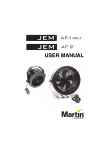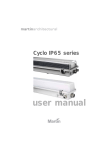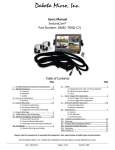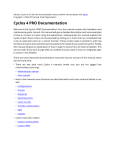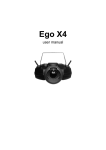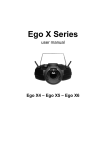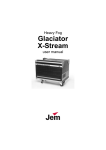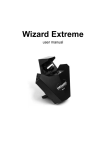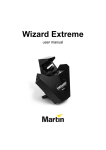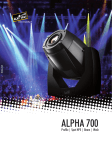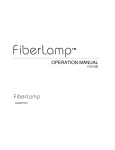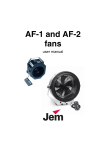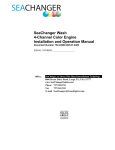Download Stage Cyclo - partirentournee
Transcript
Stage Cyclo User manual Dimensions Measurements are in millimeters 1272 209 135 © 2005 Martin Professional A/S, Denmark. All rights reserved. No part of this manual may be reproduced, in any form or by any means, without permission in writing from Martin Professional A/S, Denmark. Printed in Denmark. P/N 35000167, Rev. B Contents Product overview . . . . . . . . . . . . . . . . . . . . . . . . . . . . . . . . . . . . . 4 Introduction . . . . . . . . . . . . . . . . . . . . . . . . . . . . . . . . . . . . . . . . . 5 Safety information . . . . . . . . . . . . . . . . . . . . . . . . . . . . . . . . . . . 5 Installation . . . . . . . . . . . . . . . . . . . . . . . . . . . . . . . . . . . . . . . . . . 7 Mounting . . . . . . . . . . . . . . . . . . . . . . . . . . . . . . . . . . . . . . . . . . 7 AC power. . . . . . . . . . . . . . . . . . . . . . . . . . . . . . . . . . . . . . . . . 10 Connecting to a data link . . . . . . . . . . . . . . . . . . . . . . . . . . . . . 12 Burning in fluorescent tubes . . . . . . . . . . . . . . . . . . . . . . . . . . 13 Ambient temperature . . . . . . . . . . . . . . . . . . . . . . . . . . . . . . . . 13 Stand-alone operation . . . . . . . . . . . . . . . . . . . . . . . . . . . . . . . . 14 DIP-switch settings in stand-alone mode . . . . . . . . . . . . . . . . 15 Stand-alone operation settings . . . . . . . . . . . . . . . . . . . . . . . . 15 Single stand-alone operation. . . . . . . . . . . . . . . . . . . . . . . . . . 17 Master/slave stand-alone operation . . . . . . . . . . . . . . . . . . . . 17 DMX-controlled operation . . . . . . . . . . . . . . . . . . . . . . . . . . . . . 21 Setting a DMX control address . . . . . . . . . . . . . . . . . . . . . . . . 21 Service . . . . . . . . . . . . . . . . . . . . . . . . . . . . . . . . . . . . . . . . . . . . 24 Fluorescent tubes . . . . . . . . . . . . . . . . . . . . . . . . . . . . . . . . . . 24 Main fuse . . . . . . . . . . . . . . . . . . . . . . . . . . . . . . . . . . . . . . . . . 26 Cleaning . . . . . . . . . . . . . . . . . . . . . . . . . . . . . . . . . . . . . . . . . 26 Troubleshooting. . . . . . . . . . . . . . . . . . . . . . . . . . . . . . . . . . . . . 27 DMX protocol . . . . . . . . . . . . . . . . . . . . . . . . . . . . . . . . . . . . . . . 28 Stage Cyclo Specifications . . . . . . . . . . . . . . . . . . . . . . . . . . . . 29 Product overview A B C D E F G H I J K L DMX UT O 5 RJ4 X IN DM M N DMXIN DMX UT O O DMXIN FUS E 5 RJ4X OUT DM PUT S IN MAIN Main assembly Connections panel A Housing H AC power input B Colored tubes I DMX in (RJ-45) C Diffuser J DMX out (RJ-45) D White tube K DMX out (3-pin XLR) E Reflector L DMX in (3-pin XLR) F Clear plastic cover M DMX out (5-pin XLR) G Front frame N DMX in (5-pin XLR) O Main fuseholder 4 Stage Cyclo user manual Introduction Thank you for selecting the Martin Stage Cyclo. The Stage Cyclo is designed for wash illumination of sets, features, and artists. A patented optical system ensures effective color mixing, allowing the fixture to be positioned close to illuminated surfaces without color hot-spots. The Stage Cyclo can be controlled via DMX or programmed with a standalone light show (which it can run alone or in a synchronized group). It has a wide range of mounting options, including stacking to form dynamic colorchanging light walls. Four dimmable T5 high-output fluorescent tubes combine high efficiency, bright color and long lamp life. The Stage Cyclo features: • Full 0-100% intensity control of red, green, blue and white tubes to give RGB color mixing and fine-tuned color temperature • High output, long life T5 fluorescent tubes • Tough steel case with rubber corner protectors and carrying handle • XLR 3-pin, XLR 5-pin and RJ-45 DMX connectors. • One-tenth peak angle 107° x 121° • Optional accessories include an adjustable bracket that allows flexible rigging options. Important! Read this manual before attempting to install this product. Updated user manuals for this and all other Martin products are available from the Support area of the Martin website at http://www.martin.com. Safety information Warning! This product is for professional use only. It is not for household use. This product presents risks of lethal or severe injury due to fire and heat, electric shock and falls. Read this manual before powering or installing this fixture, follow the safety precautions listed below, and observe all warnings in this manual and on the fixture. If you have any questions about how to operate this fixture safely, contact your Martin dealer or call the Martin 24hour service hotline at +45 70 200 201. Introduction 5 Protection from electric shock • Disconnect the fixture from AC power before removing or installing a tube or any component, and when not in use. • Always ground (earth) the fixture electrically. • Do not operate the fixture if any cover or component is damaged, deformed or defective. • Use only a source of AC power that complies with local building and electrical codes and has both overload and ground fault (earth fault) protection. • Use only a power cable approved for extra hard usage. Do not operate the fixture if the power cable or power connections are damaged, deformed or defective. • Do not expose the fixture to rain or moisture. • Refer all service not described in this manual to a Martin service technician. Protection from burns and fire • Provide a minimum clearance of 25 mm (1 inch) around the fixture. • Never place filters or other materials over the clear polycarbonate cover. • The exterior of the fixture can become hot to the touch. Allow the fixture to cool for at least 5 minutes before handling. • Do not modify the fixture or install other than genuine Martin parts. • Do not operate the fixture if the ambient temperature (Ta) exceeds 40°C (104°F). Protection from injury due to falls • Ensure that all fasteners and components are secure and use an approved means of secondary attachment such as a safety cable. • Ensure that all supporting structures, surfaces and fasteners can bear ten times the weight of all fixtures installed. • Block access below the work area whenever installing, servicing or removing the fixture. • Secure stacked fixtures with safety attachments so that they cannot fall or be pushed over. 6 Stage Cyclo user manual Installation This section describes in general terms how to install the fixture, connect it to AC power and connect to a DMX controller. These procedures must be performed by qualified professionals. Mounting The Stage Cyclo features a range of mounting and stacking options when used in combination with Martin Omega clamps. Warning! Check that all fasteners, structures and surfaces used to mount the Stage Cyclo can bear at least ten times the total weight of all devices installed. A maximum of 8 Stage Cyclos may be hung vertically using the Stage Cyclo mounting bracket and Martin omega clamps. Work from a stable platform and block access below the work area when installing or servicing fixtures above headheight. Max. 8 fixtures Figure 1: Mounting bracket Riggin g optio ns The clamp attachment points on the top, ends and back of the fixture provide a range of rigging options. An adjustable mounting bracket is available as an optional accessory (P/N 91611206). Installation 7 Figure 2: Rigging with a Martin half-coupler Figure 2: Safety wire attachment Ensure that mounting hardware can bear at least ten times the total weight of the fixtures installed. Using the mounting bracket or Martin half-coupler (P/N 90602005) and Martin omega clamps (P/N 91602001), a maximum of eight fixtures may be flown in one connected stack. Anchor fixtures securely to the supporting structure with safety cables that can bear at least 10 times the weight of all suspended fixtures. Attach safety cables to every fixture using the eyebolts on the fixtures’ connections panels (see Figure 2). Do not use mounting brackets or clamps as attachment points, as this will leave fixtures unsecured. Stacking The quarter-turn clamping points allow multiple Stage Cyclos to be clamped together with omega clamps to form light walls. Ensure that stacked fixtures are secured with a safety attachment so that they cannot fall over. Figure 3: Stacking with omega clamps 8 Stage Cyclo user manual Important! Make sure that all quarter-turn fasteners are turned fully clockwise until they lock. Figure 4: Quarter-turn fasteners Placing on a su rface The Stage Cyclo can be placed flat or at an angle on a level surface and used as an uplight. The adjustable support rods allow the fixture to be placed at various angles. 57° 38° Figure 5: Placing on a level surface Release the support rods by pushing the clips on the ends of the housing. Figure 6: Support rod release Installation 9 AC power It is the installer’s responsibility to ensure that all local regulations and legal requirements are observed when installing and powering the Stage Cyclo. The Stage Cyclo is available in two models, one for 100-130 V, 60 Hz AC power only, and one for 208-250 V, 50/60 Hz AC power only. Full power compatibility and consumption data are given in the Specifications section on page 29. Many fixed installations use common neutral conductors in branch circuit distribution boxes. To avoid unintentional tripping of the RCD (ground fault circuit breaker), ensure that the Stage Cyclo’s neutral conductor is connected to AC power via the same RCD as the live conductor. Important! Stage Cyclos contain electronic ballasts that “leak” a total current of between 0.8mA and 4mA to ground (earth). Make sure that fixtures are correctly connected to ground (earthed) so that this “leakage” current can be absorbed. Because of the “leakage” current, we recommend connecting a maximum of seven Stage Cyclo fixtures per circuit where each circuit is protected by a 30mA RCD. This should avoid unintentional tripping of RCDs. Bear in mind that some RCDs rated at 30mA may trip when leakage to ground is as low as 20mA. Depending on the type of installation, electrical regulations in some countries may permit the use of RCDs with a trip current rating higher than 30mA. When considering this option, the installer must ensure that all local safety, building and electrical regulations are respected. 10 Stage Cyclo user manual Co nnecting to mains powe r Warning! Check that your local AC power voltage matches the voltage specified on the serial number label before applying power. The Stage Cyclo is supplied with a Neutrik PowerCon® NAC3FCA power cable connector that must be installed on a power cable approved for extra hard usage. The cable connector accepts power cable from 5 mm (0.20 in.) to 11 mm (0.43 in.) diameter when fitted with a white chuck, or from 9.5 mm (0.38 in.) to 15 mm (0.59 in.) diameter when fitted with a black chuck. Some common color-coding systems for AC power wiring are given below: Wire (EU) Wire (US) Pin Marking brown black live L N blue white neutral yellow/green green ground Table 1: Wiring codes Housing Insert Chuck Bushing Figure 7: Cable connector assembly To install the connector: 1. Assemble the bushing and chuck on your power cable as shown in Figure 7. Installation 11 2. Prepare the power cable and use a screwdriver to clamp the wires in the appropriate terminals in the insert as shown in Figure 8. 20 mm 8 mm [0. 787”] N [0. 315”] L Figure 8: Cable connector wiring 3. Slide the insert and chuck into the housing, making sure that the raised tabs engage in the keyways inside the housing.. 4. Use an open-ended wrench (spanner) to fasten the bushing onto the housing (max. torque: 2.5 Nm /1.8 ft-lbs). To plug the power cable in, line up the raised tab on the cable connector with the keyway in the chassis connector, push the cable connector in and twist clockwise to lock. To remove the cable connector, pull back the latch to release the lock, twist the connector counterclockwise and pull out. Additional connectors can be obtained from Martin dealers (P/N 05342804) and Neutrik® stockists Connecting to a data link Important! Never connect more than 1 data input and 1 data output. Fixtures on a serial data link must be daisy-chained in one single line, maximum 500 meters (1640 ft.) long, with maximum 32 fixtures. To exceed 32 fixtures or 500 meters, or to add branches, use an optically isolated splitter-amplifier such as the Martin RS-485 Opto-Splitter (P/N 90758060). A reliable data connection requires suitable cable. Standard microphone cable is unsuitable. For touring applications, use DMX cable designed for RS-485 devices. For fixed installations, Category 5 network cable is an acceptable alternative. Recommended minimum wire sizes are 24 AWG (0.25mm2) for runs up to 300 meters (1000 ft) and 22 AWG (0.32 mm2) for Content in the line drawings on this and the previous page is copyright ©2003 Neutrik® AG and used by permission. These illustrations may not be reproduced in any form without the written permission of Neutrik® AG. 12 Stage Cyclo user manual longer cable runs. Your Martin Architectural dealer can advise and supply suitable cable. The Stage Cyclo has RJ-45 as well as 3-pin and 5-pin XLR sockets for DMX input and output. To avoid damage to the fixture, use only one input and one output at the same time. • XLR connectors are wired pin 1 to shield, pin 2 to cold (-), and pin 3 to hot (+). There is no connection to pins 4 and 5 on 5-pin XLR connectors. • RJ-45 connectors are wired pins 7 & 8 to shield, pin 2 to signal - (cold) and pin 1 to signal + (hot). Some older fixtures have reversed polarity XLR sockets (pin 2 hot and pin 3 cold). Socket polarity is normally labelled on products and specified in user manuals. Use a phase-reversing cable between the Stage Cyclo and any device with reversed XLR connector polarity. To connect the data link: 1. Connect the DMX data output from the controller to one of the DMX input sockets of the nearest fixture. 2. Connect one DMX output of this fixture to the DMX input of the next fixture, and continue connecting output to input. 3. Terminate the link by inserting a male XLR DMX termination plug (P/N 91613017) or RJ-45 DMX termination plug (P/N 91613028) in the data output of the last fixture. Burning in fluorescent tubes For optimum tube life and performance, burn in new fluorescent tubes for 100 hours at full power. Ambient temperature Do not operate the Stage Cyclo if ambient temperature (Ta) exceeds 40°C (104°F). The Stage Cyclo can be started at full intensity from -20°C (-4°F), but needs to be at operating temperature for best dimming characteristics. When operating at extremely low ambient temperatures, start the fixture at full power and allow it to warm up for approximately 10 minutes before dimming. If dimming characteristics are impaired when running tubes at low intensity in extreme cold conditions, the fixture may need to be warmed up by periodically running tubes at higher intensity. Installation 13 Stand-alone operation In stand-alone operation, the Stage Cyclo can be used without a DMX controller. Static single colors or two-color mixes can be displayed, or fixtures can be programmed to change colors in cycles. Changes can be programmed at 1, 5, 10 or 30 second intervals. Two stand-alone operation modes are available: • In single stand-alone operation, fixtures run independently of each other. No data link is required. • In master/slave stand-alone operation, fixtures must be linked. Synchronized action in all fixtures is triggered by one “master” fixture. Programming single and master/slave stand-alone operation involves setting the p i n s o n t h e f i x t u r e ’s D I P switch. The DIP switch is protected behind a sliding cover on the back of the fixture’s housing. To access the switch, pull the knob in the connections panel recess (see illustration) and slide open the cover. Figure 9: Dip switch access An overview of the DIP switch settings is provided on the next page. A quick reference table covering DIP switch functions is also provided on the back cover of this manual. 14 Stage Cyclo user manual DIP-switch settings in stand-alone mode Pin Function 1 White active 2 Red active 3 Green active 4 Blue active 5&6 Program speed Pin 6 Pin 5 Speed OFF OFF 1 sec. steps (fastest setting) OFF ON 5 sec. steps ON OFF 10 sec. steps ON ON 30 sec. steps (slowest setting) 7 OFF = Blackout fading, ON = Crossfading 8 OFF = Run program, ON = Pause program 9 OFF = Master, ON = Slave (Note: do not set more than one fixture as master) 10 ON = Stand-alone mode. Stand-alone operation settings Activating colors DIP switch pins 1 to 4 each activate a color in the stand-alone program. Setting program speed Combinations of DIP switch pins 5 and 6 allow one of four different speeds to be set. Fading between col ors If DIP switch 7 is set to OFF (blackout fading), colors fade to almost blackout before the next color fades in. If DIP switch 7 is set to ON (crossfading), color fading overlaps. If two or more colors are active, one color fades in while another is fading out, giving a color mixing effect. For example, if red and blue are activated and crossfading is selected, colors will crossfade from red through purple to Stand-alone operation 15 blue, then back through purple to red in a continuous cycle (see example in Figure 10). 100% Red 100% Blue 50% Red 50% Blue 50% 0% 100% Red Blue 0% Red 0% Blue Time Blue Purple Red Figure 10: Crossfading between red and blue Setting a static color display In stand-alone operation, a static (non-changing) color display can be set by pausing the program at the point where it is showing the desired color. Either one color or a mix of two colors can be “frozen” in this way. To set a static color display: 1. Activate the color you wish to display (if you wish to display a two-color mix, activate these two colors) on DIP switch pins 1 to 4. 2. Set the fixture as master by setting DIP switch pin 9 to OFF. 3. Set DIP switch pins 5 and 6 to ON to activate the slowest program speed. 4. Set DIP switch pin 7 to OFF to activate crossfading and DIP switch pin 8 to OFF to activate the program. 5. When the desired color or color mix appears, pause the program by moving DIP switch 8 to ON. This color will remain “frozen” until DIP switch 8 is moved to OFF. Note that the paused color is lost when the fixture is powered off. When powering the fixture on again, DIP switch pin 8 must be moved to OFF before the program will start. 16 Stage Cyclo user manual Single stand-alone operation In single stand-alone operation, a fixture runs its own program independently of all other fixtures. To do this, the fixture must be set as a master. Activating single stand-al one operation To activate single stand-alone operation: 1. Set DIP switch pin 10 to ON (activates stand-alone mode). 2. Set DIP switch pin 9 to OFF (activates master mode). 3. Apply power and program the fixture using DIP switch pins 1 - 8 (see “DIP-switch settings in stand-alone mode” on page 15). Master/slave stand-alone operation Important! Do not set more than one fixture on a data link as master, and do not set a fixture as master on a data link with a DMX controller. Doing so may cause damage to the electronics that is not covered by the product warranty. In master/slave stand-alone operation, one master fixture transmits a synchronizing signal to slave fixtures over the data link each time it starts a new action. Slave fixtures start their next programmed action when they receive this signal from the master fixture. Programs can be identical on all fixtures, or fixtures can – subject to certain practical constraints – run programs that are synchronized but not identical. Note that: • Colors are always displayed in the order: white, red, green then blue. This means for example that if red is activated, it will always be first in the program. If red is not activated but green is activated, green will be first in the program. • Each fixture follows the program set on its own DIP switch as described in “DIP-switch settings in stand-alone mode” on page 15. More sophisticated light shows can be programmed using a DMX controller (see “DMX-controlled operation” on page 21). The synchronization signal used by Stage Cyclo fixtures is identical to that used in other DMX-controllable Cyclo fixtures with the same number of tubes, allowing these products to be combined in master/slave operation on one data link. Stand-alone operation 17 Identical light shows Master and slave fixtures can be set to behave identically. In this mode, the master sends synchronizing signals to the slaves, and all fixtures run the same light show. Each slave fixture follows the program set on its own DIP switch, so for identical operation, all fixtures’ DIP switch settings must be the same apart from pin 9, which is set to ON for slaves and OFF for the master. Synchronized non- identical light shows It is also possible to synchronize changes but program slave fixtures to behave differently from the master. To use this feature effectively, you need to plan your light show using scenes as building blocks and set the fixtures’ DIP switches accordingly. A scene is a change from one output to another. When a fixture is in slave mode, it starts a scene when it receives a synchronization signal from the master. The time taken by the scene is determined by the speed setting of the DIP switch. A slave will not respond to new synchronization signals until its scene is complete. When crossfading is selected, each color takes up one scene (fade in only). When blackout fading is selected, each color takes up two scenes (fade in and fade out). This means that a maximum of 8 scenes can be programmed with all 4 tubes activated and blackout fading selected. Each time the master fixture starts at scene 1, it sends a signal to all the slave fixtures to start at scene 1. This means that if a slave fixture has: 1. Fewer scenes than the master fixture, it will run these in a cycle until the master fixture signals that the program should start from the beginning again. 2. More scenes than the master, the additional scenes will never run, because the program will reset to the first scene when the master starts its program from the beginning. Here is an example of what will happen if a slave fixture has fewer scenes than the master fixture: Fixture setting Scene pattern Master with 6 scenes 123456 123456 123456 ... Slave with 4 scenes 123412 123412 123412 ... Program examples The following examples show how an individual fixture’s program is made up of scenes. 18 Stage Cyclo user manual The following symbols are used in program diagrams: Tube turned fully off Fade in Fade out Fade to 50% and back to 100% in one scene (applies when only one color is active and crossfading is selected) Example 1 DIP switch 7 is set to ON (crossfading) and only red is activated: Red Scene 1 1 1 1 1 1 1 1 1 1 1 1 Example 2 DIP switch 7 is set to OFF (blackout fading) and only red is activated: Red Scene 1 2 1 2 1 2 1 2 1 2 1 2 Example 3 DIP switch 7 is set to ON (crossfading) and red and blue are activated: Red Blue Scene 1 2 1 2 1 2 1 2 1 2 1 2 Example 4 DIP switch 7 is set to OFF (blackout fading) and red and blue are activated: Red Blue Scene 1 2 3 4 1 2 3 Stand-alone operation 4 1 2 3 4 19 Example 5 To achieve a rainbow effect, activate red, green and blue and set DIP switch pin 7 to ON (crossfading). Red Green Blue Scene 1 2 3 1 2 3 1 2 3 1 2 3 Activating master/slave stand- alone operation To activate master/slave stand-alone operation: 1. Power all fixtures off. 2. Set all fixtures as slaves and put them into stand-alone mode by setting DIP switch pins 9 and 10 to ON. 3. Decide which fixture to use as master and set this fixture’s DIP switch pin 9 to OFF. Note that any fixture can be set as master, but you will obtain the most reliable data signal by either setting the first fixture on the link as master or using RJ-45 DMX termination plugs at both ends of the data link. 4. When power is applied, slave fixtures will go to the next scene in their program each time the master goes to its next scene. Slave fixtures will also start scene 1 of their programs each time the master starts scene 1 of its program. 20 Stage Cyclo user manual DMX-controlled operation The Stage Cyclo may be operated with any USITT DMX (1990) lighting control device. The fluorescent tubes can be dimmed from maximum output right down to zero using four channels on a DMX controller. This allows a wide range of color shades with almost infinitely variable intensity to be obtained using additive color mixing. The color temperature of white light can be fine-tuned by running the white tube at high power and adding blue or red at low power. Replacement white tubes with various color temperatures are available (see “Accessories” on page 31). The four DMX channels are used to control the tubes as follows: • First channel: white • Third channel: green • Second channel: red • Fourth channel: blue Setting a DMX control address The DMX address, also known as the start channel, is the first of the four DMX control channels used. It must be set on the fixture’s DIP switch before the controller can send commands to the fixture. The Stage Cyclo responds to commands sent to the DMX address and the next three channels. For example, if the DMX address is set to 100, the Stage Cyclo uses channels 100, 101, 102 and 103. Allow enough channels when setting the DMX address. If control channels for two fixtures overlap, one of the fixtures will receive the wrong commands. If two or more Stage Cyclos share the same DMX address, they will receive the same commands and respond identically. Individual control will be impossible. To access the fixture’s DIP switch, slide the hatch open by pulling on the pin in the connections panel recess (see Figure 11) Figure 11: DIP switch access DMX-controlled operation 21 The default factory-set control address is ‘1’. To reset the Stage Cyclo’s DMX address: 1. Decide on a DMX address for the fixture. If you are calculating the DMX addresses for multiple fixtures, save time by using the online Martin Address Calculator at http://www.martin.dk/service/utilities/AddrCalc/index.asp (see illustration below). 2. You can also look up DIP-switch settings using the Martin DIP Switch Calculator, available for use and downloadable free at http://www.martin.dk/service/dipswitchpopup.htm If you do not have Internet access, refer to "Table 2: DMX address DIPswitch settings" on page 23. 3. Set DIP switch pins 1 through 9 to ON (1) or OFF (0) to set the address. 22 Stage Cyclo user manual To use this table, first find the DMX address in the main block in the table. Then read the settings for pins 1 - 5 to the left and read the settings for pins 6 - 9 above the address. “0” means OFF and “1” means ON. For example, to set the DMX address to 101, you need to set DIP-switch pins 1, 3, 6 and 7 to ON, as highlighted in the table. DIP switch pins setting 0 = OFF 1 = ON #1 0 1 0 1 0 1 0 1 0 1 0 1 0 1 0 1 0 1 0 1 0 1 0 1 0 1 0 1 0 1 0 1 #2 0 0 1 1 0 0 1 1 0 0 1 1 0 0 1 1 0 0 1 1 0 0 1 1 0 0 1 1 0 0 1 1 #3 0 0 0 0 1 1 1 1 0 0 0 0 1 1 1 1 0 0 0 0 1 1 1 1 0 0 0 0 1 1 1 1 #4 0 0 0 0 0 0 0 0 1 1 1 1 1 1 1 1 0 0 0 0 0 0 0 0 1 1 1 1 1 1 1 1 #5 0 0 0 0 0 0 0 0 0 0 0 0 0 0 0 0 1 1 1 1 1 1 1 1 1 1 1 1 1 1 1 1 #9 #8 #7 #6 0 0 0 0 0 0 0 1 0 0 1 0 0 0 1 1 0 1 0 0 0 1 0 1 0 1 1 0 0 1 1 1 1 0 0 0 1 0 0 1 1 0 1 0 1 0 1 1 1 1 0 0 1 1 0 1 1 1 1 0 1 1 1 1 1 2 3 4 5 6 7 8 9 10 11 12 13 14 15 16 17 18 19 20 21 22 23 24 25 26 27 28 29 30 31 32 33 34 35 36 37 38 39 40 41 42 43 44 45 46 47 48 49 50 51 52 53 54 55 56 57 58 59 60 61 62 63 64 65 66 67 68 69 70 71 72 73 74 75 76 77 78 79 80 81 82 83 84 85 86 87 88 89 90 91 92 93 94 95 96 97 98 99 100 101 102 103 104 105 106 107 108 109 110 111 112 113 114 115 116 117 118 119 120 121 122 123 124 125 126 127 128 129 130 131 132 133 134 135 136 137 138 139 140 141 142 143 144 145 146 147 148 149 150 151 152 153 154 155 156 157 158 159 160 161 162 163 164 165 166 167 168 169 170 171 172 173 174 175 176 177 178 179 180 181 182 183 184 185 186 187 188 189 190 191 192 193 194 195 196 197 198 199 200 201 202 203 204 205 206 207 208 209 210 211 212 213 214 215 216 217 218 219 220 221 222 223 224 225 226 227 228 229 230 231 232 233 234 235 236 237 238 239 240 241 242 243 244 245 246 247 248 249 250 251 252 253 254 255 256 257 258 259 260 261 262 263 264 265 266 267 268 269 270 271 272 273 274 275 276 277 278 279 280 281 282 283 284 285 286 287 288 289 290 291 292 293 294 295 296 297 298 299 300 301 302 303 304 305 306 307 308 309 310 311 312 313 314 315 316 317 318 319 320 321 322 323 324 325 326 327 328 329 330 331 332 333 334 335 336 337 338 339 340 341 342 343 344 345 346 347 348 349 350 351 352 353 354 355 356 357 358 359 360 361 362 363 364 365 366 367 368 369 370 371 372 373 374 375 376 377 378 379 380 381 382 383 384 385 386 387 388 389 390 391 392 393 394 395 396 397 398 399 400 401 402 403 404 405 406 407 408 409 410 411 412 413 414 415 416 417 418 419 420 421 422 423 424 425 426 427 428 429 430 431 432 433 434 435 436 437 438 439 440 441 442 443 444 445 446 447 448 449 450 451 452 453 454 455 456 457 458 459 460 461 462 463 464 465 466 467 468 469 470 471 472 473 474 475 476 477 478 479 480 481 482 483 484 485 486 487 488 489 490 491 492 493 494 495 496 497 498 499 500 501 502 503 504 505 506 507 508 509 510 511 Table 2: DMX address DIP-switch settings DMX-controlled operation 23 Service With long-life fluorescent tubes and virtually no moving parts, the Stage Cyclo is almost service-free. Fluorescent tubes The Osram high output T5 tubes fitted as standard meet color specifications for at least 10 000 hours, after which color intensity may gradually fall. Average tube life is 20 000 hours, but note that tube life will vary depending on operating conditions. Tub e positio ns Tube positions in the Stage Cyclo are identified as shown below: Marking in fixture Marking on tube R OSRAM FQ 54W/60 RED G OSRAM FQ 54W/66 GREEN B OSRAM FQ 54W/67 BLUE Reference illustration B G R No marking. Tube OSRAM FQ 54W/860 Daylight located above diffuser. The burning positions of fluorescent tubes affect their warm-up times, operating temperature, light output and tube life. For best results: • Install tubes so that the manufacturer’s markings are all at the same end of the fixture. • If the fixture is mounted in a vertical position or at an angle from the horizontal, place the ends of the tubes that carry the manufacturer’s markings at the lower end of the fixture (in a cold environment, i.e. where temperatures are generally around or below freezing point, locate the markings at the upper end of the fixture). 24 Stage Cyclo user manual Chan ging a tube To change a tube: 1. Disconnect the fixture from AC power and allow to cool for 5 minutes. 2. For access to the white tube, use a 3mm Allen key to remove the 8 retaining screws and remove the front frame (G) and clear plastic cover (F). Be ready to catch the reflector, as this is a loose fit in the housing, but note that a ground (earth) lead connects the reflector to the housing. Disconnect this lead and remove the reflector. 3mm F G Figure 12: Access to white tube 3. To remove a tube, press on the metal caps at both ends of the tube and rotate the tube 1/4 turn in whichever direction is easiest. Then slide the tube’s terminal pins out of their sockets. Support the tube at both ends as it is released. Figure 13: Tube removal Service 25 4. For access to the colored tubes, remove the eight Pozidriv PZ2 screws and remove the diffuser. Figure 14: Access to colored tubes 5. When installing new tubes, line them up so that the manufacturer’s markings on all tubes are at the same end of the fixture. Slide the tube’s terminal pins fully into their sockets and rotate the tube 1/4 turn to engage the pins. Check that the tube is held securely in the sockets. 6. Replace all components – remembering to attach the earth strap to the reflector – before reapplying power. Main fuse The main fuseholder is located in the connections panel recess (see “Product overview” on page 4´). Using a flat-head screwdriver, turn the fuseholder cover approximately 1/8 turn to release the cover and main fuse. Isolate the fixture from power and make sure power cannot be reapplied accidentally before changing the fuse. Never replace a fuse with one of a different type or rating. See “Power” on page 30 for main fuse details. Cleaning Turn off power to the fixture before cleaning, and use a damp cloth to wipe clean. 26 Stage Cyclo user manual Troubleshooting Problem Probable cause(s) Remedy No response from fixture when No power to fixture. Check power connections. power is applied. Ground fault protection circuit Reset RCD. If problem breaker (RCD) has tripped. persists, have an electrician replace the RCD or reduce the number of fixtures powered via one RCD. Fixture does not respond correctly to DMX control. Controller not connected. Check DMX data link. Inspect connections and test cables. Repair or replace as necessary. Incorrect DMX addressing. Check address setting on fixture and controller. Data link not terminated. Insert DMX termination plug in unused socket of last fixture on data link. Fixture on link set as master. Check that all fixtures are set as slaves (DIP switch pin 9 ON). Defective fixture. Bypass fixtures one at a time until normal operation is regained. Fixtures do not behave Two fixtures operating as correctly in master/slave mode masters. Defective fixture. Poor quality light output and/or Tube or tubes not burnt in. color rendering. Tube defective. Troubleshooting Check that only one fixture is set as master. Bypass fixtures one at a time until normal operation is regained. Run fixture for at least 100 hours to burn in tubes. Disconnect fixture and replace tube. 27 DMX protocol Start code = 0 Channel 1 2 3 4 Value Percent Function 0-2 3-252 253-255 0 1 - 99 100 White intensity Tube off Intensity 1→100% Intensity 100% 0-2 3-252 253-255 0 1 - 99 100 Red intensity Tube off Intensity 1→100% Intensity 100% 0-2 3-252 253-255 0 1 - 99 100 Green intensity Tube off Intensity 1→100% Intensity 100% 0-2 3-252 253-255 0 1 - 99 100 Blue intensity Tube off Intensity 1→100% Intensity 100% Stage Cyclo Specifications PHYSICAL L x W x H . . . . . . . . . . . . . . . . .1272 x 209 x 135 mm (50 x 8.2 x 5.3 in.) Weight . . . . . . . . . . . . . . . . . . . . . . . . . . . . . . . . . . . . . 10.5 kg (23.1 lbs) Shipping weight . . . . . . . . . . . . . . . . . . . . . . . . . . . . . . 11.5 kg (25.3 lbs) Shipping dimensions . . . . . . . . 1300 x 350 x 210 mm (52 x 14 x 8,4 in.) Fixture color. . . . . . . . . . . . . . . . . . . . . . . . . . . . . . . . . . . . . . . Gunmetal SOURCE Light source . . . . . . . . . . . . . . . . . . . . . . T5 fluorescent tubes (4 x 54W) Approved lamp type. . . . . . . . . . . . . . . . . . OSRAM T5 high output 54W Color authenticity . . . . . . . . . . . . . . . . . . . Guaranteed to 10 000 hours Average tube life . . . . . . . . . . . . . . . . . . . . . . . . . . . . . . . . 20 000 hours PHOTOMETRICS Efficiency . . . . . . . . . . . . . . . . . . . . . . . . . . . . . . . . . . . . . . . . . . . . . 28% Total Output . . . . . . . . . . . . . . . . . . . . . . . . . . . . . . . . . . . 3976 lumens Half peak angle C0 (horizontal) . . . . . . . . . . . . . . . . . . . . . . . . . . . . . 95° Half peak angle C90 (vertical) . . . . . . . . . . . . . . . . . . . . . . . . . . . . . . 83° One-tenth peak angle C0 . . . . . . . . . . . . . . . . . . . . . . . . . . . . . . . . 107° One-tenth peak angle C90 . . . . . . . . . . . . . . . . . . . . . . . . . . . . . . . 121° Illuminance . . . . . . . . . . . . . . . . . . . . . . . . . . . . . . . 2066/distance2 [lux] Measurement conditions . . . . . . . . . . . . . . . . . . . . . . . . . . . 230V, 50Hz Measurement source. . . . . . . . . . . Osram T5 FQ54W/840+/60+/66+/67 DYNAMIC EFFECTS 0-100% dimmable tubes . . . . . . . . . . . . . . . Red, green, blue and white CONTROL AND PROGRAMMING Control . . . . . . . . . . . . . . . . . . . . . . . . . . . . . . . USITT DMX512 (1990) Receiver . . . . . . . . . . . . . . . . . . . . . . . . . . . . . . . . . . . . . . . . . . .RS-485 DMX addressing . . . . . . . . . . . . . . . . . . . . . . . . . . . . . . . . . . DIP switch Data input/ output . . . . . . . . . . . . . . . . . . . . 3-pin and 5-pin XLR, RJ-45 Number of DMX channels . . . . . . . . . . . . . . . . . . . . . . . . . . . . . . . . . . 4 INSTALLATION Floor or surface mounting with adjustable legs Stacking/side-by-side/end-to-end: lockable with Martin omega brackets Rigging with optional adjustable mounting bracket and omega brackets Orientation . . . . . . . . . . . . . . . . . . . . . . . . . . . . . . . . . . . . . . . . . . . . .Any Minimum free space around fixture . . . . . . . . . . . . . . . . 25 mm (1 inch) POWER AC power, 230 V model. . . . . . . . . . . . . . . . . . . . 198 - 250 V, 50/60 Hz AC power, 110 V model . . . . . . . . . . . . . . . . . . . . . . . 100 - 120 V, 60 Hz AC input. . . . . . . . . . . .Neutrik PowerCon® (A-type) lockable connector Main fuse, 230 V model. . . . . . . . . . . . . . . . . . . . . 2 AT (P/N 05020009) Main fuse, 110 V model . . . . . . . . . . . . . . . . . . . 2.5 AT (P/N 05020010) Maximum current and power @ 100 V, 60 Hz . . . . . . . . . . . . . . . . . . . . . . . . . @ 120 V, 60 Hz . . . . . . . . . . . . . . . . . . . . . . . . . @ 208 V, 60 Hz . . . . . . . . . . . . . . . . . . . . . . . . . @ 230 V, 50 Hz . . . . . . . . . . . . . . . . . . . . . . . . . @ 240 V, 50 Hz . . . . . . . . . . . . . . . . . . . . . . . . . @ 250 V, 50 Hz . . . . . . . . . . . . . . . . . . . . . . . . . 2.2 A, 218 W, PF 0.998 2.0 A, 235 W, PF 0.999 1.2 A, 235 W, PF 0.993 1.1 A, 234 W, PF 0.988 1.0 A, 233 W, PF 0.986 1.0 A, 231 W, PF 0.983 PF = power factor THERMAL Maximum ambient temperature (Ta) . . . . . . . . . . . . . . . . . 40°C (104°F) Minimum ambient temperature (started at full power) . . . . . -20°C (-4°F) Maximum total heat dissipation (calculated) . . . . . . . . . . . . 737 BTU/hr. Cooling . . . . . . . . . . . . . . . . . . . . . . . . . . . . . . . . . . . . . . . . . Convection CONSTRUCTION Housing . . . . . . . . . . . . . . . . . . . . . . . . . . . . . . . . . . . . . . . . . Mild steel Optics . . . . . . . . . . . . . . . . . . . . . . . . . . High specular 99.9% aluminum Protection factor . . . . . . . . . . . . . . . . . . . . . . . . . . . . . . . . . . . . . . . IP20 APPROVALS European safety: EN 60598-1 EN 60598-2-17 + Corr + A2-1997 CSA C22.2, NO 166 pending ANSI/UL 1573 pending INCLUDED ITEMS Red T5 high output tube . . . . . . . . . . . . . . . . . . OSRAM T5 FQ 54W/60 Green T5 high output tube. . . . . . . . . . . . . . . . . OSRAM T5 FQ 54W/66 Blue T5 high output tube . . . . . . . . . . . . . . . . . . OSRAM T5 FQ 54W/67 Cool white (4000 K) T5 high output tube . . . . OSRAM T5 FQ 54W/840 2 x omega brackets incl. 1/4 turn fasteners. . . . . . . . 2 x P/N 91602001 Neutrik PowerCon® NAC3FCA power cable connector . P/N 05342804 User manual . . . . . . . . . . . . . . . . . . . . . . . . . . . . . . . . . . P/N 35000167 ACCESSORIES Stage Cyclo mounting bracket. . . . . . . . . . . . . . . . . . . . . Omega bracket with 1/4 turn fasteners . . . . . . . . . . . . . . Warm white tube (2700 K, Osram T5 FQ 54W/827) . . . . Daylight white tube (6000 K, Osram T5 FQ 54W/860) . . DMX link termination plug RJ-45 . . . . . . . . . . . . . . . . . . DMX link termination plug male XLR 3-pin . . . . . . . . . . . RJ-45 patch cable (250 mm/ 9.8 in.) . . . . . . . . . . . . . . . XLR male to RJ-45 converter . . . . . . . . . . . . . . . . . . . . . XLR female to RJ-45 connector . . . . . . . . . . . . . . . . . . . 50 x CAT5 network cables - 2 m (6.5 ft) . . . . . . . . . . . . . 30 x CAT5 network cables - 5 m (16.4 ft) . . . . . . . . . . . . 15 x CAT5 network cables - 10 m (32.8 ft) . . . . . . . . . . . P/N 91611206 P/N 91602001 P/N 97020009 P/N 97020011 P/N 91613028 P/N 91613017 P/N 11840088 P/N 11840087 P/N 11840086 P/N 91611044 P/N 91611045 P/N 91611046 ORDERING INFORMATION Stage Cyclo, 208-250 V, 50/60 Hz. . . . . . . . . . . . . . . . . . P/N 90350000 Stage Cyclo, 100-130 V, 60 Hz . . . . . . . . . . . . . . . . . . . . P/N 90350100 8. ON = Pause OFF = Play 9. ON = Slave or DMX OFF = Master 3. Green 2. Red 10. ON = Stand-alone OFF = DMX ON 1. White 1 2 3 4 5 6 7 8 910 4. Blue 7. ON = Crossfading OFF = Blackout fading 5/6. Program speed Quick reference Stage Cyclo DIP switch settings Martin Professional A/S - Olof Palmes Allé 18 - DK-8200 Aarhus N - Denmark Phone: +45 87 40 00 00 Internet: www.martin.com




































